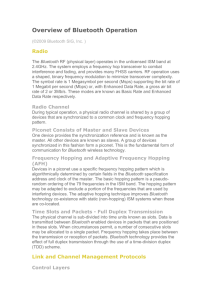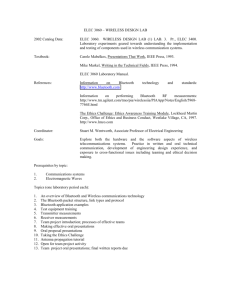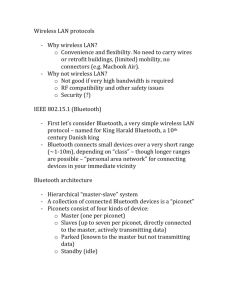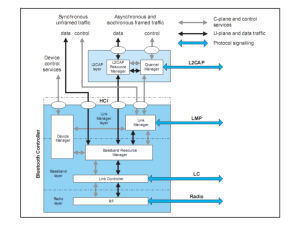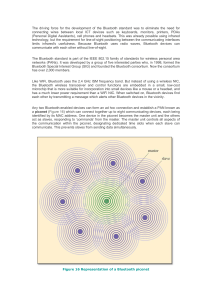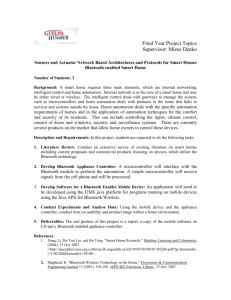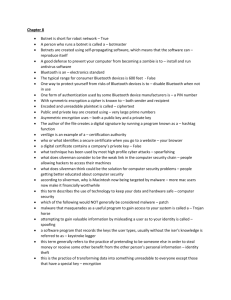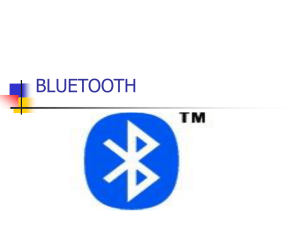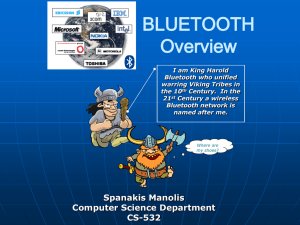Bluetooth
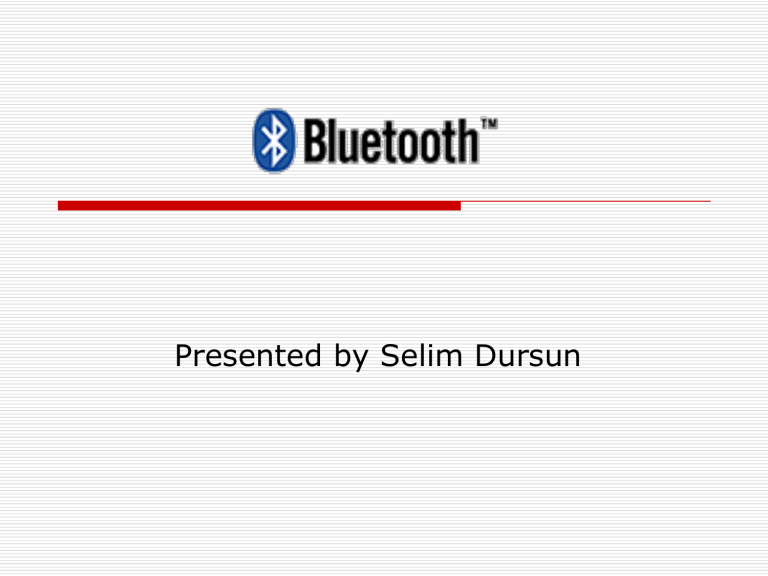
Presented by Selim Dursun
Bluetooth
What is bluetooth?
Introduction
Overview
Specifications & Layers
Profiles
Ad-hoc networking
Qualification
Products & Future Usage
What is bluetooth?
Bluetooth wireless technology is an
open specification for a low-cost,
low-power, short-range radio technology for ad-hoc wireless communication of voice and data
anywhere in the world.
Intoduction
1994 Ericsson gets interested in wireless connections from mobile telephones to other devices like PDAs and accessories like
Headsets
Forming the SIG (SpecialInterestGroup) with 4 other members (IBM, Intel, Nokia,
Toshiba) in order to develop a wireless standard for communication between mobile devices
Introdution
Today over 2000 members
2 main priorities:
Cheap
Lower energy consumption
IEEE 802.15 committee standardizes the physical and link layer
SIG still enhances Bluetooth
two versions in future possible
(SIG vs IEEE)
Overview
Originally conceived as a cable replacement technology
Other usage models began to develop:
Personal Area Network (PAN)
Ad-hoc networks
Data/voice access points
Wireless telematics
Overview
Advantages
Bluetooth: interoperable
IrDA: line of sight needed, point-to-point
WLAN: higher power consumption
Disadvantages
Bluetooth: only up to 1 Mbps
IrDA: much cheaper, faster (up to 16 Mbps)
WLAN: faster (up to 11 Mbps)
WLAN and Bluetooth interfere each other
(both are using the ISM band)
Specifications & Layers
specification protocol stack
Layers
Bluetooth Radio
Baseband
LMP (Link Manager Protocol)
HCI (Host Controller Interface)
L2CAP (Logical Link Control and Adaptation
Protocol)
RFCOMM (Radio Frequency Communication)
SDP (Service Discovery Protocol)
Bluetooth Radio
the lowest defined layer of the
Bluetooth specification
operating in the 2,4 GHz ISM Band
accomplishes spectrum spreading by frequency hopping (FHSS) from 2.402
GHz to 2.480 GHz
Bluetooth Radio
3 different power classes
Power Class1: long range (100m,100mW)
Power Class2: mid range (10m,1-2,5mW)
Power Class3: short range (0.1-10m,1mW)
signal strength adjustment
Baseband
the physical layer of the Bluetooth that provides
Error correction
Flow control
Hopping sequence
Security
hopping through 79 channels
data is divided in packets
access code: e.g. timing synchronization
header: e.g. packet numbering, flow control, slave address
payload: voice, data or both
Baseband
Connection Modes describes the set of rules by which all bluetooth devices must abide in order to establish a link a communicate with one another
STANDBY : not connected in a piconet
ACTIVE : active participation on the channel
Power Saving Modes
SNIFF : slave listens to the channel at a reduced rate
(decreasing of duty cycle ) least power efficient
HOLD : data transfer is held for a specific time period, medium power efficient
PARK : synchronized to the piconet but does not participate in traffic
Baseband
Security Modes
non-secure
encryption enforced by application layer
encryption enforced by link layer
For devices
trusted device
untrusted device
For services
require authorization and authentication
require authentication
open to all devices
Audio
two codecs: PCM and CVSD
both at 64kbit/s
synchronous connection oriented(SCO) links
time-critical
no retransmission
errors appear as background noise
LMP (Link Manager Protocol)
provides authentication, link setup and link configuration including power surveillance
takes place as a service provider
communication with LM PDUs
(protocol data units)
HCI (Host Controller Interface)
provides a command interface to baseband controller and link manager
also to hardware status, control and event register
Bluetooth defined Host Controller Transport
Layers:
UART (HCI over serial interface)
RS232(HCI over serial interface)
USB(HCI over USB interface e.g. USB dongle)
L2CAP (Logical Link Control and
Adaptation Protocol)
provides a connection-oriented and connectionless service to upper layer
protocols with quality-of-service functions using multiplexing, segmentation and reassembly
two link types defined in Baseband layer:
1. SCO (synchronous connection-oriented)
2. ACL (asynchronous connection-less)
BUT ONLY ACL is supported by L2CAP
(SCO not planned)
RFCOMM (Radio Frequency
Communication)
Provides emulation of serial ports
Supports up to 60 simultaneous connections
Differentiates between two device types:
Type 1: communication end points (e.g. printer or headsets)
Type 2: devices which are part of communication (e.g. modems)
But in the protocol itself no distinction is made, some information is for type 1 other for type 2
SDP (Service Discovery Protocol)
discovers which services are available
identifies the characteristics of the services
uses a request/response model where each transaction consists of one request protocol data unit (PDU) and one response PDU
SDP is used with L2CAP
is optimized for the dynamic nature of bluetooth
SDP does not define methods for accessing services
SDP (Service Discovery Protocol)
Profiles
how bluetooth is used
describe how implementations for a specific use must be written
defines options in each protocol
defines parameter ranges
profiles are used to solve interoperability problems between different manufacturers’ products
Profiles
Ad-hoc-networking
piconet
decentral, one master up to 7 slaves
up to 255 parked slaves
point to point or point to multipoint conn
unique bluetooth device address
scatternet
overlapping of two piconets, up to 10
different hopping sequences
peer to peer (P2P) network
Ad-hoc-networking
a: piconet with a single slave
b: piconet with a multi slave
c: scatternet
Qualification
aims interoperability between all bletooth devices
no license fees
bluetooth devices must support same profiles
bluetooth logo guarantees interoperability
Qualification
no line of sight required
you can use it everywhere
bluetooth chip
integrated
power management
not really cheap
Automatic ad-hoc networking
(invisible) e.g.automaticdata synchronisation
Products
Notebook PCs & desktop computers
Printers
PDAs
Other handheld devices
Cell phones
Wireless periperals:
Headsets
Cameras
Access Points
CD Player
TV/VCR/DVD
Telephone Answering
Devices
Cordless Phones
Cars
Products
2004 Toyota Prius
– hands free calls
Toshiba Washer &
Dryer – downloads the washer/dryer software for new clothes!
Nokia N-gage
Digital Pulse
Oximetry System
Future Usage
Home Automation
Home Entertainment/Games
Electronic Commerce/M-Commerce
Industrial Control
Surveillance
Access Control
Location Based Services
Current Trials: Shopping Malls, Train
Stations
Thats All !
Thanks for listening...


